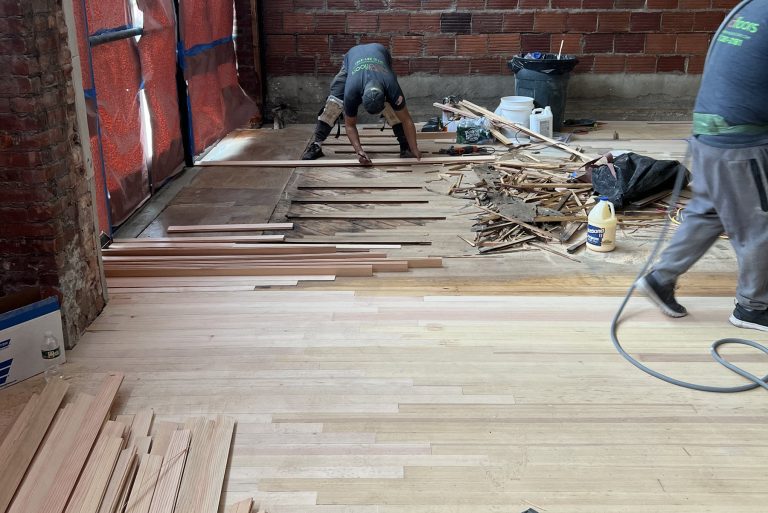When refinishing wood floors, sanding plays a critical role in achieving a smooth and beautiful surface. However, sanding can be a daunting task if not approached correctly. In this comprehensive guide, we will explore the dos and don’ts of sanding your wood floors, ensuring that you achieve stunning results while avoiding common pitfalls. From preparation to the sanding process and finishing touches, let’s dive into the essential tips for successfully sanding your wood floors.

I. Do: Prepare your space adequately
Before diving into the sanding process, proper preparation is key. Here are some important steps to follow:
- Clear the area: Remove all furniture, rugs, and any other obstacles from the room. This will provide an unobstructed space to work in and prevent potential damage.
- Inspect and repair: Carefully inspect the wood floor for any loose boards, protruding nails, or damages. Repair or replace damaged sections to ensure a smooth and even surface.
- Clean the floor: Thoroughly sweep or vacuum the floor to remove dust, dirt, and debris. A clean surface will help prevent scratches during the sanding process.
- Cover vents and openings: Seal off air vents and any other openings in the room to prevent dust from spreading throughout your home.
II. Don’t: Neglect safety precautions
Sanding wood floors involves the use of heavy machinery and potentially harmful substances. Keep yourself protected by following these safety measures:
- Wear protective gear: Use safety goggles, a dust mask, and ear protection to shield yourself from flying debris and excessive noise.
- Ventilate the area: Open windows and doors or use fans to promote airflow and minimize dust concentration. Proper ventilation is crucial, especially with stains or finishes emitting fumes.
- Turn off electricity: Ensure you turn off the power supply to any electrical outlets or switches in the room to eliminate the risk of accidents.
III. Do: Choose the right sanding equipment
Selecting the appropriate sanding equipment is essential for achieving desirable results. Consider the following factors:
- Rent or buy a floor sander: Renting a drum sander from a home improvement store is cost-effective for larger areas but won’t leave the same results as a professional commercial sander running on 220V. That’s why it’s always best to hire a professional company who own these machines. You would also need an edger that will attack the perimeter of the room.
- Use the right sandpaper: Start with coarse grit sandpaper (around 36 or 40) to remove any existing finish or deep scratches. Gradually progress to finer grits (60, 80, and 120) to achieve a smoother finish. Be sure to follow the manufacturer’s recommendations for your specific sander.
IV. Don’t: Apply excessive pressure
When sanding wood floors, letting the sander do the work is crucial. Applying excessive pressure can cause uneven sanding and potentially damage the wood. Follow these guidelines:
- Maintain a light touch: Hold the sander firmly but avoid putting too much weight on it. Allow the machine’s weight and the sandpaper’s grit to remove the material efficiently.
- Keep the sander moving: Always keep it in motion while it’s turned on. Holding it in one spot for too long can result in noticeable sanding marks or grooves.
V. Do: Sand in stages
To achieve a uniformly smooth surface, it’s best to sand your wood floors in stages. Here’s a recommended approach:
- Coarse sanding: Begin with the coarsest grit sandpaper appropriate for your floor’s condition. Sand along the grain of the wood, moving slowly and steadily. Overlap each pass to ensure consistent results.
- Intermediate sanding: Switch to finer grit sandpaper for the second sanding stage. Repeat the process, gradually smoothing out the surface and removing any remaining imperfections.
- Fine sanding: Use the finest grit sandpaper the manufacturer recommends for the final sanding stage. This step is crucial for achieving a polished and ready-to-finish surface.
VI. Don’t: Skip the sanding sequence
Following the proper sanding sequence is vital to achieving optimal results. Avoid skipping grits or rushing through the process. Each grit level serves a purpose in refining the surface and ensuring a seamless finish.
VII. Do: Address edges and corners
Sanding the main area of your wood floor is essential, but paying attention to the edges and corners is equally important. Here’s how to approach these areas:
- Edges: Use an edge sander or a hand-held sanding tool with fine-grit sandpaper to sand along the room’s perimeter. Be cautious not to tilt the sander, which can result in uneven sanding.
- Corners: Use a detail sander or sandpaper wrapped around a small block for corners and tight spaces. Take your time to achieve consistent results without causing damage.
VIII. Don’t: Neglect dust containment
Sanding wood floors creates a significant amount of dust, which can be hazardous and spread throughout your home. Follow these steps to effectively contain dust:
- Use a dust containment system: Consider using a vacuum attachment or a dust collection system designed specifically for floor sanding. These devices minimize airborne dust and collect debris efficiently.
- Regularly empty the dust bag: If you’re using a drum sander, ensure the dust bag is empty or replaced as needed. A full bag can hinder the sander’s performance and increase dust dispersion.
IX. Do: Finish with care
After completing the sanding process, it’s time to apply a finish to protect and enhance the beauty of your wood floor. Keep these tips in mind:
- Clean the floor: Thoroughly clean the floor to remove any residual dust before applying the finish. Use a vacuum or damp cloth to ensure a dust-free surface.
- Choose the right finish: Select a finish that suits your preferences and the specific needs of your wood floor. Options include polyurethane, oil-based finishes, or environmentally friendly water-based finishes.
- Follow manufacturer’s instructions: Read and follow the manufacturer’s guidelines for the chosen finish. Apply it evenly using the recommended tools, such as a brush, roller, or lambswool applicator.
- Allow for proper drying time: Ensure the finish has ample time to dry and cure before allowing foot traffic. Follow the manufacturer’s recommended drying times for optimal results.
Sanding your wood floors can breathe new life into your home’s interior, revitalizing the natural beauty of the wood. By following the dos and don’ts, you can confidently approach the sanding process, achieving professional-looking results while avoiding common mistakes. Remember, proper preparation, safety precautions, and a methodical approach will help you achieve stunning wood floors that will envy all who enter your home.
Contact the professionals at North Jersey Wood Floors today for a free quote!





